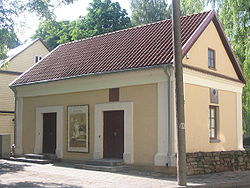Panevėžys
Panevėžys is a city in the north of Lithuania. It is the fifth-largest city. The city is 50 km².[2]
City municipality | |
 | |
| Coordinates: 55°44′N 24°21′E / 55.733°N 24.350°ECoordinates: 55°44′N 24°21′E / 55.733°N 24.350°E | |
| Country | |
| County | |
| Municipality | Panevėžys city municipality |
| First mentioned | 1503 |
| Granted city rights | 1837 |
| Area | |
| • City municipality | 50.1 km2 (19.3 sq mi) |
| Elevation | 61 m (200 ft) |
| Population (2020) | |
| • City municipality | 85,885 |
| • Density | 1,714.3/km2 (4,440/sq mi) |
| • Urban | 124,412[1] |
| Time zone | UTC+2 (EET) |
| • Summer (DST) | UTC+3 (EEST) |
| Postal code | 35xxx |
| Website | www |
History
Panevėžys was first mentioned in a document, that was written in 1503, September 7th. In the document, the Grand Duke of Lithuania and the King of Poland gifted some land to a parson from Ramygala. In exchange for the land, the parson had to build a church in the land to fight paganism. A small wooden church was built here.[3][4]
In 1940, June 5th, the city was taken over by the Soviet Union.[2]
Panevėžys Media
Grand Duke Alexander Jagiellon, founder of Panevėžys in 1503
Imperial Russian Army soldiers in the present-day Independence Square
Parade of the Lithuanian Army troops in front of the Cathedral of Christ the King, 1930
Church of the Holy Trinity which was turned into an Eastern Orthodox church following the suppression of the Uprising of 1831
References
- ↑ http://appsso.eurostat.ec.europa.eu/nui/show.do?dataset=urb_lpop1&lang=en
- ↑ 2.0 2.1 "Panevėžys". www.vle.lt (in lietuvių). Retrieved 2021-03-25.
- ↑ "Istorija". www.panevezys.lt (in lietuvių). Archived from the original on 2021-04-29. Retrieved 2021-04-29.
- ↑ "Panevėžio istorija". www.vle.lt (in lietuvių). Retrieved 2021-04-29.










